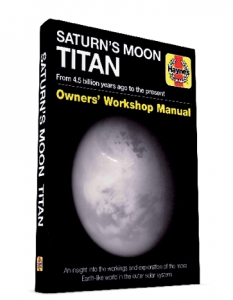Once again, The Haynes Owners’ Workshop Manual series embarks on a journey into space and time (from 4.5 billion years ago to the present, as the subtitle has it). This edition purports to provide “an insight into the workings and exploration of the most Earth-like world in the outer solar system”, Saturn’s largest moon Titan.
It is strange to think that such a well-illustrated and produced book could be written about a tiny astronomical body of which only blurred images exist. A couple of the best, produced full-page in the volume, are reminiscent of cataract simulations that have the viewer squinting and refocusing to try and make sense of the image. But a plethora of colourful Earth-analogue images and clear colour diagrams make up for this; according to the author, “the same physical processes which shape our planet’s surface produce strikingly similar landforms on Titan”.
One example is the river valley. Although the working fluid is not water – and is thought to be liquid methane – the geomorphological processes are indeed remarkably alike. Using measurements from the Cassini-Huygens mission, the author explains that “the ability to transport sediment for a given riverbed slope and depth of liquid ends up being rather similar”. By comparing rounded rocks on Earth with those imaged by the Huygens lander, he concludes that the latter have been “eroded as they tumbled in an energetic flow like a flash flood”. This type of analysis shows, among other things, that science is transferable knowledge – universal if you like – and certainly brings that classroom geography alive. However, the author is also aware of its limitations: “we cannot say how much time has passed since it last rained there”, he admits.
A bonus for many readers is a nine-page table of place names on Titan, which provides a cultural window on planetary nomenclature. While there is arguably little originality in naming features after the Tibetan mythical land of Shangri La or Coleridge’s imaginary country of Xanadu, it is refreshing to see features named after planets from Herbert’s Dune series (Arrakis Planitia), Tolkien’s Middle Earth (Erebor Mons) and Asimov’s Foundation trilogy (Seldon Fretum) – a plain, mountain and strait, respectively. All we need now, in terms of nomenclature, is for Haynes to move beyond its historical ‘Owners’ Manuals’ and admit that they just publish books!











